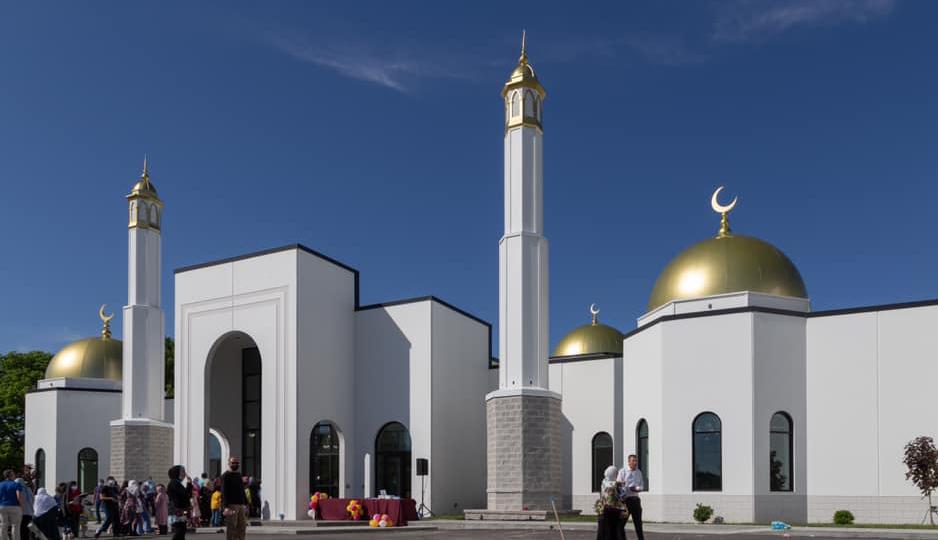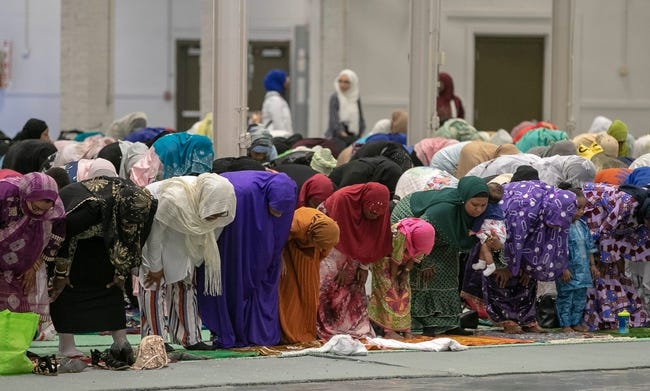The Muslim community of Indianapolis is a small but integral part of the city’s population. Muslim residents may account for less than 1 percent of the Indianapolis population, but their social, political, economic, and cultural impact has been significant, especially in the 21st century.

Muslims have been present in North America since the 1500s, but it is unclear when Muslims first arrived in Indianapolis. Formerly enslaved African Muslims or Syrian immigrants, who came in significant numbers during the 1890s, are the likeliest candidates as Indiana’s first Muslims. It was not until the era of the Great Migration of African Americans between World Wars I and II that Muslim residents created formal community organizations.
The first Indianapolis organizations were new religious movements: Ahmadi Mission on Fayette Street in 1926 and Moorish Science Temple No. 15 on Indiana Avenue in 1930. For much of the 20th century, the majority of Muslims in Indianapolis were African Americans, who established the Nation of Islam mosque in the 1950s and a Sunni Muslim group in 1973 that eventually built Al-Fajr (“Morning”) mosque on Cold Spring Road.

The passage of the Immigration and Naturalization Act of 1965 had a profound impact on Muslim life across the United States. Indianapolis played a major role in galvanizing the religious and social life of the new immigrants who arrived mainly from Arabic-speaking countries in North Africa and the Middle East as well as the South Asian countries of India, Pakistan, and Bangladesh.
In the 1970s, Indianapolis became the new home for the Muslim Student Association, which was originally headquartered in Gary. In 1982, that group established the (now located in Plainfield), which became the largest dues-paying Muslim American organization in North America. The group was tasked mainly with providing training and other services to the thousand or so new American mosques that were formed by the end of the 20th century.
Among those who settled in Indianapolis after the passage of the Immigration and Naturalization Act were engineers, doctors, and scientists who rose to prominence in the health care, pharmaceutical, defense manufacturing, chemical, and textile industries as well as academia. At IUPUI, the city’s largest university, Muslims were represented broadly among faculty, staff, and students. The campus’ fifth chancellor, Nasser Paydar, was an immigrant from Iran. The immigrants who came after 1965 would be joined by a Muslim refugees from Eritrea, Somalia, Afghanistan, Iraq, and Syria.
By the 21st century, there were Muslims in Indianapolis from every corner of the globe, including Southeast Asia, West Africa, East Africa, Europe, and Central Asia. Along with native-born African American Muslims, the new immigrants and their children transformed the civic landscape of Indianapolis, establishing mosques, Islamic schools, and advocacy groups such as the and the Indiana Muslim Advocacy Network.

By 2020, there were over a dozen mosques in addition to numerous workplace and school-based communities that prayed together on Fridays, the day that Muslims meet for congregational prayers. These congregations, including Al-Haqq, Al-Huda, Mosque No. 74, Mumineen, Noor, Nur Allah, Sahaba, Salam, and Zainabia, represented every major denomination of Islam in the United States: Sunni, Shi‘a, Ahmadi, and Nation of Islam. As in the Muslim world, the super-majority were Sunni Muslim. More racially integrated than any other major religious community in Indianapolis, Sunni Muslim congregations still reflected various sociological and ideological differences, including class, ethnicity, and religious teachings.
Muslims in Indianapolis, as elsewhere in the United States, have faced anti-Muslim prejudice, discrimination, and violence. This was especially true during times of conflict between the United States and Muslim-majority countries, including the 1979 Iranian revolution, the Iraq war of 1991, the 2001 war in Afghanistan, the 2003 war in Iraq, and the Syrian civil war of 2011.
Other instances include Gov. Mike Pence’s attempt in 2015 to prevent the resettlement of Syrian refugees in the state, including Indianapolis. Ultimately, his executive order was ignored by aid groups and thrown out in federal court. In 2018, Muslims in Carmel faced opposition to the building of the town’s first mosque despite its support from the mayor and community faith leaders. In 2019, local Muslim Mustafa Ayoubi was murdered by a man who yelled anti-Muslim insults as he shot Ayoubi twice in the back.
Despite such anti-Muslim sentiments, the Indianapolis Muslim community has succeeded in establishing new businesses, increasing participation in public life, and producing some of the city’s best-known political, thought, and faith leaders. In 2002, for example, Marion County voters elected David Shaheed as Superior Court Judge. Then in 2008, Indianapolis native André Carson was elected the second Muslim to serve in the U.S. Congress. In 2020 Senator Fady Qaddoura became the first Muslim American elected to the Indiana State Senate. By the first part of the 21st century, Muslim participation in all sectors of Indianapolis society was increasing with no signs of a slowdown ahead.

Help improve this entry
Contribute information, offer corrections, suggest images.
You can also recommend new entries related to this topic.